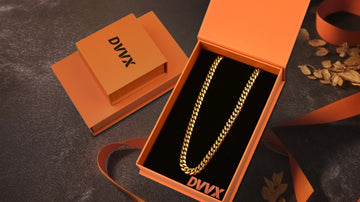Hip hop culture has always had a close connection to jewelry and chains. As far back as the 1970s, early hip hop pioneers like Grandmaster Flash and the Furious Five wore simple gold chains and rings as part of the emerging cultural style. But it was in the 1980s and 90s that thick, flat gold chains known as "Cuban links" became a staple fashion accessory in hip hop.
Cuban link chains are a type of rope chain that is distinguished by their wide, flat links that lay closely together. Unlike a standard cable chain whose links are round or oval, Cuban link chains have a smooth, solid gold surface thanks to their unique flat links. The links are designed to fit flush against one another, creating the illusion of one solid, flexible gold sheet. These chains come in various widths like 3mm, 5mm, 8mm, 10mm or more, and are known for having a very high gold content between 14-24 karats. Their unique look and ability to lay flat is what made them a popular statement piece in hip hop fashion.
Origins
The origins of Cuban link chains can be traced back to Cuban immigrants who settled in Miami during the 1970s and 1980s. At the time, Cuba was undergoing economic turmoil and many Cubans sought refuge in the United States, forming a vibrant Cuban community in southern Florida.
Within this community, customized gold jewelry became a prominent symbol of wealth and status. The most iconic were chunky gold chains made of oval links that lay flat against the chest when worn. These chains came to be known as "Cuban links" or "Cuban chains," derived from the immigrant community that popularized them as bold representations of prosperity.
The Cuban links stood out for their unique interlocking design that created a flexible and fluid chain, unlike the rigid feel of a traditional curb or cable chain. The chunky links maximized the shine and luster of the gold, making a bold visual statement. For newly prosperous Cuban immigrants, these chains symbolized having "made it" in America.
Early Adoption in Hip Hop
The early hip hop stars of the 1980s were some of the first to help popularize the cuban link chain. Rappers like Big Daddy Kane, Eric B. and Rakim, and Run DMC were frequently seen wearing thick gold cuban link chains as part of their signature looks. For them, the flashy jewelry was a status symbol that represented success. It showed that they had "made it" in the music industry.
More broadly, gold jewelry became intrinsically linked with hip hop culture during this era. In the 1980s, many rappers came from economically disadvantaged backgrounds. Wearing gold chains and rings was a way of displaying that they now had the means to afford luxury items. Cuban links also served as an expression of success for a community that historically lacked access to wealth and resources. The prominent hip hop acts of the '80s paved the way for bold, ostentatious jewelry to become a defining part of hip hop fashion. Their influence helped popularize the cuban link chain as a staple within the culture.
The Rise of Bling Era
Cuban link chains rose to prominence alongside hip hop's "bling era" in the 1990s and 2000s. As hip hop went mainstream and rappers gained more wealth, flashy jewelry became a status symbol and display of excess. Big Cuban link chains in gold, often with diamond accents, became a staple fashion statement.
Rappers flaunted the chains in music videos, on stage, and on the streets as a flex and sign of success. The larger and more intricate the chain, the more status it carried. Certain rappers became well known for their signature oversized Cuban links, such as Jay Z with his iconic Roc-A-Fella piece. Posses and rap crews also had custom matching Cuban links made to demonstrate unity and wealth.
During this era, jewelry became more than just an accessory but an integral part of a rapper's image and display of power. Their chains commanded attention and respect. The bling aesthetic exemplified hip hop's decadent side and themes of conspicuous consumption. Cuban links remain embedded in hip hop style as a nod to that legacy.
Regional Styles
The styles of Cuban link chains differed between the East Coast and West Coast hip hop scenes. On the East Coast, Cuban links were often thicker and more understated. New York rappers like Biggie Smalls and members of the Wu-Tang Clan wore Cuban link chains with larger, solid gold links. Their chains made a statement while still maintaining a classic, almost conservative style.
On the West Coast, rappers embraced a flashier aesthetic. Snoop Dogg, Dr. Dre, and 2Pac wore Cuban links with diamond-encrusted gold that fully embraced the "bling" era. Their chains were lighter in color, thinner in width, and incorporated precious stones and gems. Snoop Dogg in particular was known for his extensive collection of diamond-covered Cuban link chains in different styles. While East Coast Cuban links exuded wealth, West Coast Cuban links shouted it.
The regional sensibilities were a reflection of the different vibes between East Coast and West Coast hip hop overall. The styles also aligned with how rappers wanted to portray themselves and their success through fashion statements. Cuban links remain popular in hip hop today, but modern rappers often opt for a fusion of the classic East Coast and flashy West Coast styles.
Custom Cuban Links
The trend of custom-made, diamond-encrusted Cuban link chains took off in the early 2000s with the rise of bling culture in hip hop. Rappers wanted to show off their wealth by wearing the biggest and most expensive chains possible. These custom Cuban links often featured colored diamonds, large diamond-encrusted pendants, and elaborate designs.
Some of the most extravagant Cuban link chains have belonged to rappers like Jay-Z, Lil Wayne, and Gucci Mane. Jay-Z's cuban link chain designed by Jacob the Jeweler reportedly cost $250,000 and contained more than 340 carats. Lil Wayne's diamond-studded Cuban link chain was valued at $150,000. Gucci Mane's Cuban link with huge red and white diamond snowflake pendants was estimated to be worth over $400,000. Other rappers like Rick Ross, Migos, and 2 Chainz have also sported custom Cuban link chains costing 6 figures or more.
While basic Cuban link chains can cost just a few thousand dollars, these custom, diamond-dripped versions aim to show wealth and status. The bigger and more expensive, the better. However, some have criticized how excessive these chains are, arguing the money could be better spent. But for many rappers, these customized Cuban links represent both their hip hop credibility and star status.
Evolution Over Time
The cuban link chain has come a long way since its early adoption in hip hop culture. Originally worn as a symbol of status and wealth, the style and meaning of the cuban link chain has evolved significantly from the 80s to today.
In the 80s and 90s, wearing an extravagant, oversized cuban link chain was a way to show off your success. The bigger and flashier the chain, the more status it commanded. Cuban links during this time were almost comically large, sometimes weighing up to 5kg or more. They were worn proudly as "bling" and a conspicuous display of wealth.
Over time, cuban link chains became more refined and versatile. The oversized links of the 80s and 90s slowly shrunk down to more modest sizes. Styles like the Figaro chain interspersed small and large links in creative patterns. Cuban link chains also became popular in precious metals like rose gold and white gold, diversifying from the traditional yellow gold.
While a cuban link still maintains an air of luxury, the flashy, in-your-face styles have given way to more sophisticated designs. Modern cuban link chains have a classic, understated look infused with hip hop edge. Smaller link sizes let them be layered and personalized with pendants, charms, or customized engraving.
The cuban link chain is still widely popular in hip hop culture today. Rappers across all generations from Jay-Z to Lil Uzi Vert wear these iconic chains. Their staying power comes not just from the lavish look, but from the nostalgia and nod back to hip hop's golden era roots. The cuban link chain has proven over decades that it's much more than just bold bling or a status symbol - it's a timeless part of hip hop style.
Criticisms
Cuban link chains have faced criticism over the years, primarily directed at the largest and most expensive chains worn by hip hop artists. Detractors argue these heavy gold chains promote excess materialism and conspicuous consumption.
Many believe wearing expensive jewelry solely to show off wealth is vain and superficial. Critics contend focusing too much on flaunting expensive chains takes attention away from an artist's actual music and talents. Additionally, displaying extreme wealth can reinforce negative stereotypes about rappers.
However, supporters counter that Cuban links are a symbol of hip hop culture and African American identity. Much like cars and clothes, chains represent personal style and hard-won success for many rappers. Cuban link chains also connect to heritage, with gold holding deep significance in African culture.
Rappers argue chains are an expression of their identity, not a sign of empty materialism. Chains symbolize the journey from poverty to stardom for many artists. Supporters believe criticizing jewelry disregards this context and unfairly targets rappers based on stereotypes. There are reasoned defenses on both sides regarding Cuban links as status symbols.
Impact on Fashion
Cuban link chains have had a major influence on men's fashion both within and outside of hip hop culture. While initially popularized by rappers and hip hop artists in the 1980s and 90s, the bold, attention-grabbing style of Cuban links quickly crossed over into mainstream fashion.
Today, Cuban link chains are a prominent staple of men's jewelry and urban streetwear looks. Even high fashion brands like Gucci and Louis Vuitton have embraced the Cuban link aesthetic in their jewelry and accessory collections. Cuban link pieces have become widely available at retailers from streetwear boutiques to department stores.
Outside of hip hop culture, Cuban link chains have been adopted by celebrities, athletes, and influencers. The chunky, blinged-out look projects confidence and status. Cuban link chains offer a way for men to show off their personal style.
While the origins trace back to hip hop, Cuban links have clearly expanded far beyond those roots. The aesthetic has proven widely influential, bringing a hip hop-inspired look into the mainstream menswear world. Cuban link chains now represent a versatile jewelry option for modern men looking to accessorize their wardrobe with a bold, eye-catching statement piece.
Conclusion
Cuban link chains have become an iconic symbol of hip hop culture and the emergence of the 'bling' aesthetic. As we've covered, these chunky gold chains originated in Miami in the 1970s and 80s when Cuban immigrants brought their jewelry making traditions to South Florida. Early hip hop pioneers like Run DMC and LL Cool J embraced the bold, attention-grabbing chains as part of their signature looks.
During the 90s, figures like Biggie, Puff Daddy and later rappers embraced showy jewelry as a display of success. This lead to the rise of 'bling rap' focused on extravagant wealth and luxury goods. Regional styles emerged with rappers from places like New Orleans and Texas putting their own spin on Cuban links. Over time, custom diamond and gemstone Cuban links became popular as rappers competed to show off their status.
While some have criticized the materialism of hip hop's fascination with flashy jewelry, Cuban links remain deeply ingrained as a symbol of hip hop culture. The chunky, attention-grabbing style reflects the audacious attitude and swagger that define hip hop artists. For better or worse, Cuban link chains are an iconic part of hip hop history and continue to influence artists today. Their evolution from Miami immigrant communities to worldwide fame speaks to hip hop's power to shape styles and culture.
















































